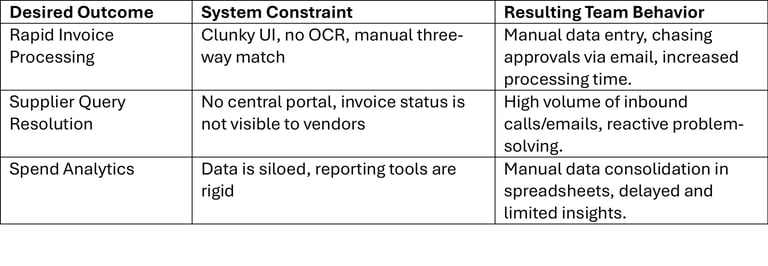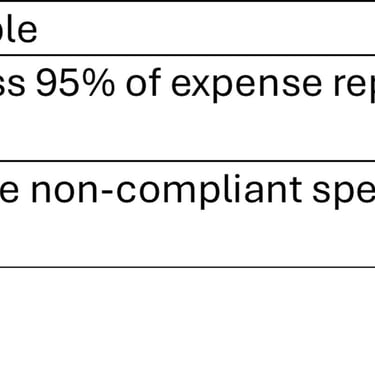Your GBS Outcomes Are Suffering. Your Systems Are Why
Carl Beebe
You are looking at your global business services (GBS) dashboard - the metrics are not where you want them.
Days Sales Outstanding (DSO) is creeping up, invoice processing costs are flat, and employee satisfaction scores in the service center have dipped.
You have a talented, motivated team. So why are the outcomes falling short?
The common response is to push for more training or stricter process adherence but this approach misses the core issue. Your team is likely not the problem. The environment you ask them to operate in is.
When performance falters, look past the people and at the systems that dictate their work. Desired outcomes rarely fail because people do not care. They fail for three primary reasons: the goals are unclear, the systems do not support the intent, or the guidance changes too often to follow.
This article examines how outdated systems create these failure points and what you can do to address them.
#1: The Gap Between Intent and System
Most shared services centers operate on systems, like foundational ERPs, that were designed for financial record-keeping, not for efficient, user-friendly workflows.
You want a procure-to-pay (P2P) process that is fast, transparent, and minimizes manual touch.
Your system, however, may require multiple screens, manual data entry, and offers no visibility to business partners.
This creates a fundamental disconnect. Your team is forced to develop manual workarounds- spreadsheets, emails, status-tracking documents- just to meet basic objectives. These activities are inefficient, introduce risk, and pull your skilled employees away from value-added analysis.
We would laugh at an organization still using Windows 8, but how many of our core systems were created before 2015?
Consider the misalignment in a typical P2P process:


The system actively works against the strategic intent. No amount of team motivation can fix a tool that is not built for the job.
#2: Unclear Goals Amplified by Rigid Systems
The second failure point is a lack of clear goals. Leadership often communicates success through Service Level Agreements (SLAs), such as "process 98% of invoices within 30 days." While measurable, an SLA is not a strategic outcome. It is a task metric. A true outcome is tied to business value, like "improve working capital by reducing DSO by 5 days."
When your team's primary focus is hitting a transactional SLA, they will prioritize actions that meet that narrow target, even if it harms the broader business goal. For example, they might ignore complex but high-value invoices to focus on processing simple ones quickly.
Outdated systems magnify this problem. They are not configured to track value-based metrics. Their dashboards report on transaction speed and volume, reinforcing the focus on tasks over value. To shift your team's focus, you must first provide them with goals that matter and then give them tools that measure that contribution.


#3: The High Cost of Strategic Whiplash
The third killer of outcomes is constantly shifting guidance. Your organization decides to acquire a new company, centralize a different function, or pivot to a new service delivery model. These strategic shifts are necessary. However, in an environment of legacy technology, they are poison to productivity.
Outdated systems are brittle and expensive to change. A simple modification to a workflow or report can require months of development and testing. By the time the system is updated to support a new strategic direction, leadership's priorities may have already changed again.
This creates "strategic whiplash" for your GBS team. They are caught between old processes and half-implemented new ones. Morale drops, project fatigue sets in, and employees grow cynical about new initiatives. Based on our analysis of transformation programs, we estimate that over 40% of GBS initiatives that stall or fail are directly hampered by the inability of legacy technology to adapt to new business requirements.
Strip Away the Noise to Find the Core Truth
Strip away the noise of misaligned metrics and outdated systems, and you are left with a core truth: People are the driving force behind your organization's success.
Your best finance and accounting professionals did not join your company to perform manual data entry and chase approvals. They came to solve problems, analyze data, and partner with the business.
Your current systems may force them into the role of data clerk. This is a waste of talent and a direct cap on the value your GBS organization can deliver.
The strategic imperative is clear.
Modernizing your process architecture through workflow automation, process mining, and user-centric platforms - is not an IT project.
It is a talent strategy. It is about removing the friction that prevents good people from delivering great outcomes.
By automating the repetitive tasks enforced by old systems, you free your professionals to focus on the work that requires human intellect: analysis, exception management, and strategic advising.
Key Takeaways
When GBS outcomes disappoint, investigate the systems and goal clarity before you scrutinize the people. The operating environment is often the root cause.
Your systems must directly support your strategic intent. If your team relies on constant manual workarounds, your technology is fundamentally misaligned with your goals.
Shift from measuring task-based SLAs to tracking value-driven metrics. Define success by the business impact your GBS organization delivers, not just its transactional efficiency.
Modernizing your systems is essential for agility. Legacy technology makes it slow and expensive to adapt to strategic changes, leading to team burnout and failed initiatives.
The ultimate goal of system modernization is to liberate your skilled professionals from low-value tasks, enabling them to focus on analysis and business partnership.
